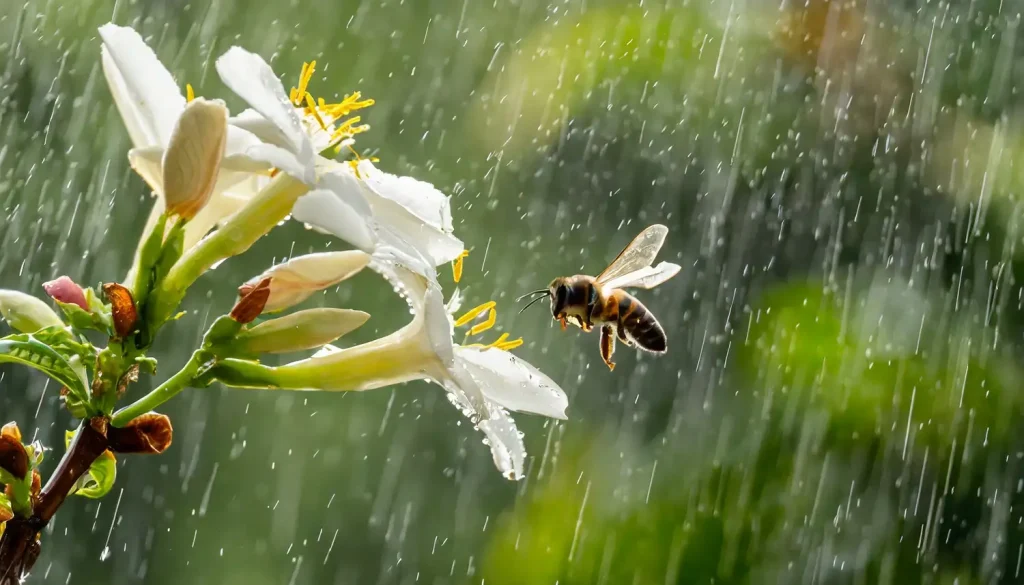Table of Contents
Bees can fly in light rain but generally avoid flying in heavy rain. Their small size and relatively large body surface area make them susceptible to getting weighed down by water droplets, which can impede their flight. In heavy rain, bees prefer to stay in their hives to protect themselves and their colony.
In the below paragraphs, we will take a more detailed look at this topic.
Key Takeaways
- Bees can fly in the rain, but it depends on the rain’s intensity.
- Rain affects bees’ flight abilities, body temperature, visibility, and foraging opportunities.
- Bees struggle to navigate through raindrops due to their small size and low flying speed.
- Rain can impact bee flight, navigation, energy expenditure, and risk of chilling.
- Bees stay dry during rain by staying inside the hive, relying on their hydrophobic hair, and using their wings for protection.
- Bees can sense storms approaching by being able to detect atmospheric pressure, humidity, and wind speed.
- Beekeepers can help bees during storms by providing shelter and securing the hive.
- If you find a bee in the rain, you can help by moving it to a dry, safe spot, providing warmth and energy, and allowing it time to recover.
- Bees tend to be more active after rain due to increased foraging opportunities, water collection, and favorable temperatures.
Do Bees Fly When It’s Raining?
Bees, as incredibly resilient and adaptable creatures, are typically affected by weather conditions such as rain. When it’s raining, forager bees usually don’t fly or go foraging for resources. There are several reasons for this behavior:
Hindered Flight Abilities
Raindrops can significantly impact a bee’s ability to fly. As small creatures, even a single raindrop is enough to weigh them down and make flying difficult. Moreover, the water droplets can compromise their wings, affecting their aerodynamics and reducing their ability to navigate efficiently.
Lowered Body Temperature
Bees are ectothermic, meaning that their body temperature is influenced by the surrounding environment. During rainfall, temperatures usually drop, which can make it challenging for bees to maintain their optimal body temperature for flight. A bee’s flight muscles need to be at a certain temperature to function effectively (usually around 95°F (35°C)), so when the temperature falls below this threshold their flight muscles become sluggish and they struggle to fly.
Reduced Visibility
Rainy conditions can reduce visibility, making it harder for bees to locate flowers and find their way back to the hive. Bees rely on their vision for navigation, and heavy rain can disorient them. This increases the risk of getting lost or expending more energy than necessary to return to the hive.
Dampened Foraging Opportunities
Rain can affect the availability of pollen and nectar as it may wash pollen away from flowers and dilute nectar. This means that even if bees were able to fly during rain, they would have a harder time finding adequate resources.
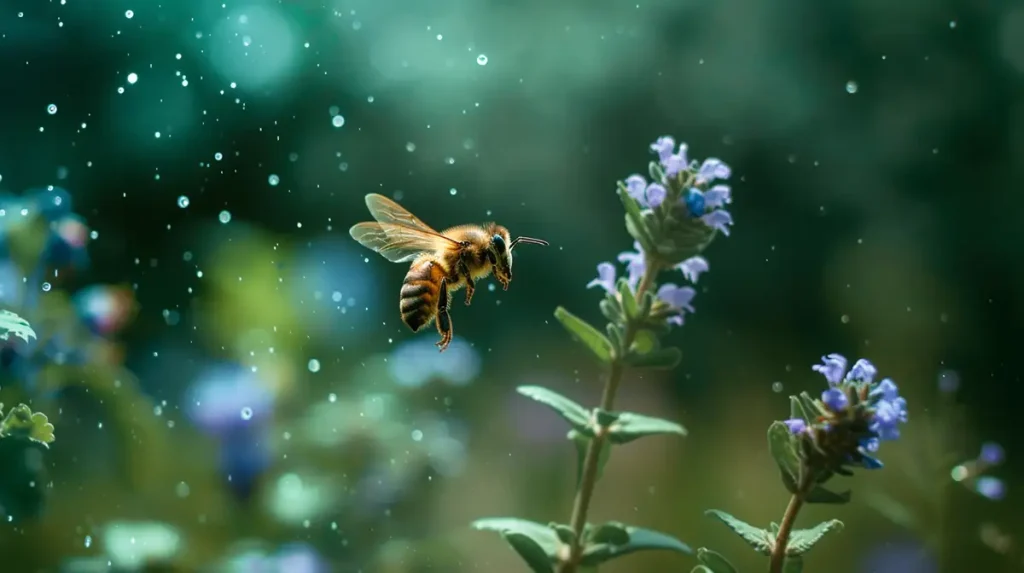
How Does Rain Affect Bee Flight?
Rain can have a significant impact on bee flight and their ability to forage for nectar and pollen. There are several factors to consider when discussing the effects of rain on bee flight. Although touched upon above, here is some more detail:
Reduced Flying Time
During rainy periods, bees may not be able to fly at all or will experience reduced flying time. This is due to the fact that bees prefer to fly when the weather is warm and dry. Wet and cold conditions make it difficult for them to maintain their body temperature and fly efficiently. Consequently, they may stay inside the hive, which can result in decreased foraging activity and a potential reduction in honey production.
Difficulty in Navigating
Large raindrops can interfere with a bee’s ability to navigate. Bees rely on their vision and an internal sun compass to find their way to and from the hive. Raindrops falling on their eyes and body can obscure their vision, making it difficult for them to maintain their bearings. Additionally, overcast conditions often accompany rain, which can further hinder their navigation abilities by reducing the sunlight necessary for their internal sun compass.
Increased Energy Expenditure
Flying in the rain can be more energy-consuming for bees. The added weight of raindrops on their wings and bodies combined with the increased air resistance from flying through the rain, makes it harder for them to fly. As a result, they need to expend more energy to maintain flight, which can shorten their foraging trips and decrease their overall efficiency.
Risk of Chilling
Bees are ectothermic, which means their body temperature is regulated by their environment. In cold and wet conditions, bees are at risk of becoming chilled. A chilled bee may become sluggish, unable to fly, and could potentially die if not able to return to the hive to warm up. Therefore, rain can pose a direct threat to individual bees and impact the health of the colony as a whole.
- Carter, Anthony (Author)
- English (Publication Language)
- 194 Pages - 02/28/2024 (Publication Date) - Independently published (Publisher)
| Factor | Detail | Impact on Bees |
|---|---|---|
| Reduced Flying Time | Bees have decreased or no flight during wet and cold conditions as they struggle to maintain body temperature. | Decreased foraging and potential reduction in honey production. |
| Difficulty in Navigating | Raindrops interfere with vision and navigation, compounded by overcast conditions affecting the internal sun compass. | Loss of bearings and increased difficulty in returning to the hive. |
| Increased Energy Expenditure | Added weight and air resistance from rain requires more energy to fly. | Shortened foraging trips and reduced efficiency. |
| Risk of Chilling | Bees can become sluggish and unable to fly in cold, wet conditions due to their ectothermic nature, risking death if they cannot return to the hive. | Direct threat to individual bees and overall colony health. |
This table summarizes the key points about how rain affects bee flight, illustrating the various challenges bees face during inclement weather.
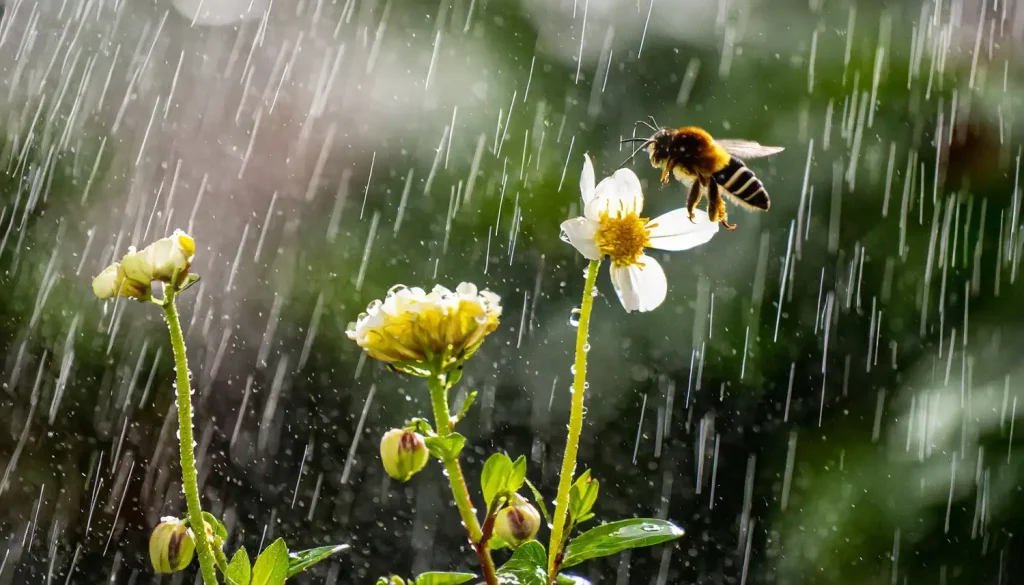
Can Bees Navigate Through Raindrops?
While bees can navigate through raindrops to some extent, their small size and relatively low flying speed make it difficult for them to avoid colliding with raindrops. When it starts to rain, bees tend to seek shelter to avoid the adverse conditions.
The Impact of Rain on Bees
Rain can have a substantial impact on a bee’s ability to fly and navigate. The weight and force of raindrops can knock bees off course, making it difficult for them to maintain their flight path. Additionally, a bee’s wings can become weighed down by water droplets, which can slow their flight and reduce their maneuverability.
Bee Behavior During Rain
Bees are aware of the challenges posed by rain, and they usually avoid flying in it. They have the ability to sense atmospheric changes in pressure, humidity, and temperature, which helps them anticipate rain. Once they sense that rain is imminent, they tend to stay in their hives until the weather improves. This behavior is important for the survival of the colony, as it conserves energy and reduces the risk of bees becoming lost or injured in the rain.
How Bees Deal with Getting Wet
If a bee does get caught in the rain, it will typically try to find shelter as quickly as possible. Bees have a water-repellent coat of hair, which can help them shed water droplets and stay relatively dry. However, if a bee becomes too wet, it may struggle to fly and could even become grounded. In such cases, it will attempt to groom itself and remove excess water from its body and wings before attempting to fly again.
How Do Bees Prepare For Heavy Rains?
Bees are incredibly adept at sensing changes in the weather, including the approach of heavy rains. To prepare, they work extra hard to gather food before the storm hits, as the rain can make it difficult for them to forage for pollen and nectar. When the skies darken, signaling an impending downpour, bees return to their hive to hunker down. Inside, they use their wings to generate heat, keeping the hive warm and dry. They also propolize, or seal, the hive entrances with a sticky substance called propolis to prevent water from getting in. This way, the bees stay safe and their home remains cozy and dry, even during the heaviest of rains.
Can Honey Bees Fly if They Get Wet?
Honeybees can fly through light rain, but they prefer not to get wet. If a bee gets drenched, it can become grounded. Their wings are delicate and when waterlogged, they become too heavy to allow for flight. Bees are like tiny helicopters; they need their wings to be light and dry to lift off and buzz around. If a bee does get caught in the rain and gets wet, it will seek shelter on a plant or tree and wait for its wings to dry. Once the sun comes out or the wind dries the moisture, the bee will do a little shake-off and get back to flying and foraging for the colony.
What Happens To Bees In Bad Weather?
Bees, like many other creatures, are affected by adverse weather conditions. In bad weather such as heavy rain, strong winds, or low temperatures, bees tend to stay inside their hive to avoid exposure to the elements. Nevertheless, the way they cope with bad weather varies depending on the specific conditions they encounter.
Heavy Rain and Strong Winds
During heavy rainfall, bees generally stay inside the hive to avoid getting wet. We know that bees’ wings can become waterlogged, making flying difficult or impossible, but strong winds also make it challenging for bees to navigate and can blow them off course. In these situations, they will stay in the hive and focus on maintaining the internal temperature and caring for the brood.
Cold Temperatures and Snow
In colder temperatures, bees will cluster together inside the hive to maintain warmth. Worker bees surround the queen bee, vibrating their bodies to generate heat. They continuously rotate from the outer part of the cluster to the center, ensuring that all members of the colony stay warm. During the winter months, bees rely on stored honey and pollen to provide the energy they need to maintain their body heat and survive the cold weather.
Extreme Heat
During extremely hot weather, bees may face challenges as well. Overheating inside the hive can be a threat to the colony’s survival as it can cause the wax combs to melt and damage the hive structure. To counteract this, bees will fan their wings to circulate air and cool the hive. They may also bring water into the hive and spread it on the combs to help with evaporative cooling.
Do Bees Know When a Rain Storm is Coming?
Bees are indeed sensitive to changes in weather conditions, including the approach of rain and storm conditions. They can detect these changes through a combination of cues, such as air pressure, humidity, and wind speed. Their ability to sense these environmental changes helps them to adapt their behavior to optimize their foraging and safety.
Atmospheric Pressure and Bee Behavior
One of the primary indicators that bees use to anticipate storms is the change in atmospheric pressure. Bees are sensitive to barometric pressure changes, and when a storm is approaching, the pressure typically decreases. This drop in pressure signals the bees to stay close to the hive or return to it, in order to protect themselves from adverse weather conditions.
Humidity and Foraging
Another factor that bees can sense is the level of humidity in the air. When humidity increases, it becomes more difficult for bees to collect nectar and pollen from flowers. High humidity can make the nectar more diluted, and in some cases, it can cause the pollen to clump together. Sensing these changes, bees might reduce their foraging activities, which can be an indication that a storm is on the way.
Wind Speed and Flight
Wind speed and direction also play a crucial role in the ability of bees to detect incoming storms. When wind speeds increase, flying becomes more challenging for bees, which can impact their foraging efficiency. As the storm approaches and the wind speed rises, bees are more likely to stay within or close to the hive, to avoid the risk of being blown off course or getting lost.
Can You Help Bees During a Rain Storm?
As bees are aware that a storm is coming, they are likely to return to their hive and stay inside during the bad weather. They may also try to seal any cracks with propolis to keep the hive more secure. Nevertheless, there are things that you as a beekeeper can do to keep the bees safe inside their hive.
Some beekeepers will move their hives to a more sheltered location before a storm hits as high winds could topple a hive. A hive cover might also be worthwhile to prevent the roof from blowing off. This would be disastrous as it would mean rain in the hive that would result in damage and the loss of many bees. Straps around the hive and a weighted cover should keep bees safe until the worst of the weather has passed.
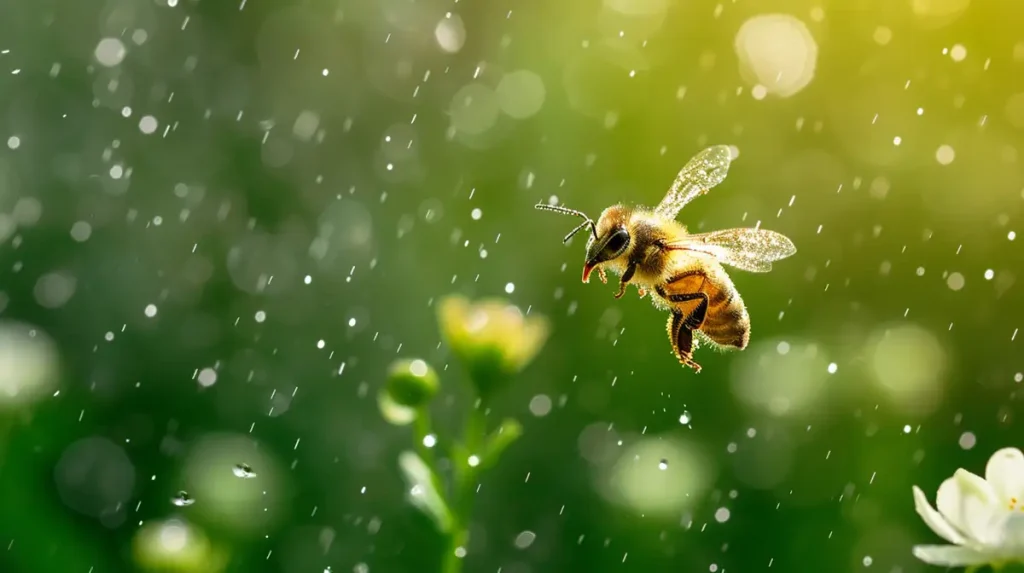
What Happens If A Bee Gets Wet?
When a bee gets wet, it’s like a swimmer wearing clothes in the pool; movement becomes much more difficult. A bee’s wings are coated with a thin layer of wax, which helps repel water, but if they get soaked, the extra weight hampers their ability to fly. The wet wings also lose their aerodynamic properties, making flight inefficient or impossible. On the ground, a wet bee will do a little shiver dance, rapidly vibrating their flight muscles to generate heat and speed up the drying process. This is crucial because a grounded bee is more vulnerable to predators and has a limited time to return to the safety of its hive. If the bee can’t dry off in time to fly back, it may not survive the cold temperatures that often come with rain.
How Do Bees Stay Dry During Rain?
Bees have developed several strategies to stay dry during rain, as it is essential for their survival and the well-being of their colonies. These strategies include staying inside the hive, relying on their fuzzy hair, and using their wings to shield themselves from raindrops.
Staying Inside the Hive
One of the primary ways bees stay dry during rain is by remaining inside their hive. Worker bees are quite sensitive to changes in weather, and they can detect an approaching rainstorm. When this happens, they communicate with other bees in the colony and stay indoors to protect themselves, their queen, and the brood. Additionally, the hive’s structure itself provides a natural barrier against rain and other elements.
Fuzzy Hair
Bees are equipped with a dense covering of tiny hairs on their bodies (particularly bumblebees), which provide insulation and help to keep them dry in wet conditions. The hair is hydrophobic, meaning it repels water, causing raindrops to bead up and roll off the bee’s body. This feature is crucial as a wet bee would have difficulty flying and maintaining its body temperature.
Using Wings for Protection
When caught in a sudden downpour, bees can use their wings to shield themselves from raindrops. They can rapidly vibrate their wings to create a sort of “umbrella” and deflect incoming raindrops. This technique, however, is not as effective as the other two strategies and is typically a last resort for bees caught in unexpected rain.
What To Do If You Find a Bee in the Rain
If you come across a bee struggling in the rain, it’s important to understand that these creatures can have a difficult time flying in wet conditions. The raindrops can weigh them down, making it challenging to return to their hive. Here’s what you can do to help a bee in the rain:
1. Carefully Move the Bee to a Dry, Safe Spot
Find a dry, protected area, such as under a tree or shrub, where you can move the bee. Gently pick up the bee using a small piece of paper or a flat, soft object. Be cautious not to harm its wings or legs. Keep in mind that bees are generally not aggressive when they’re cold and wet, so the risk of getting stung is low.
2. Provide Warmth and Energy
Bees need to regain energy to fly back to their hive. In this situation, you can provide them with a simple sugar solution to help them recover. Mix 2 parts sugar with 1 part water and place a few drops of the mixture close to the bee. Avoid using honey, as it can introduce harmful bacteria to the bee.
3. Give Them Time to Recover
Once you have provided the bee with warmth and energy, give it some time to recover. It may take a while for the bee to dry off and regain the strength to fly. Keep an eye on the bee from a distance, ensuring it is safe from predators and further rain.
4. Let the Bee Fly Away
When the bee has regained enough strength, it will fly away to rejoin its colony. If the bee has not recovered after several hours or if the weather does not improve, you might need to contact a local beekeeper or beekeeping association for further advice.
Remember, bees play a vital role in pollination and maintaining a healthy ecosystem. Helping a bee in the rain is a small act of kindness that can make a significant difference in the life of the bee and the environment.
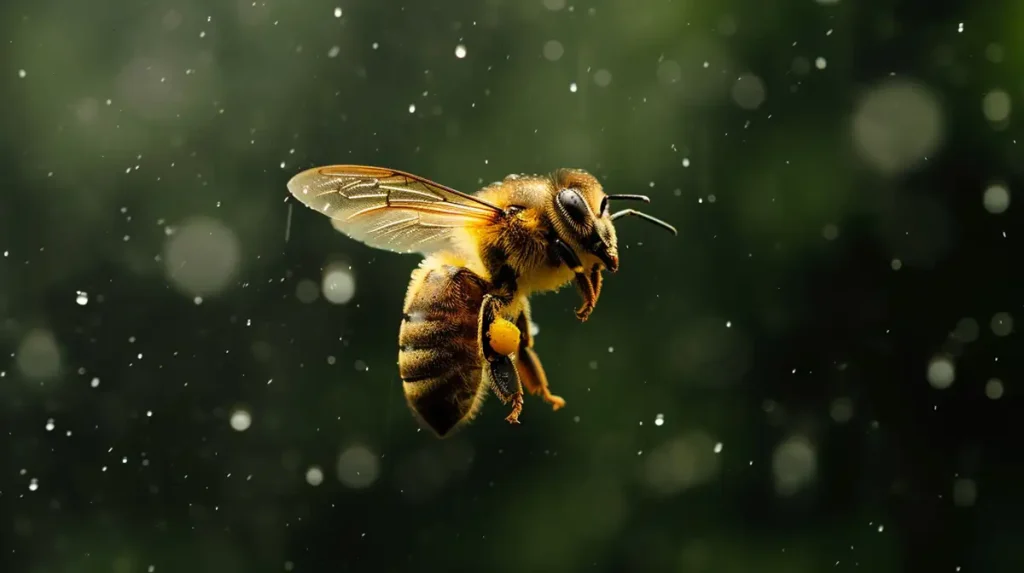
Are Bees More Active After Rain?
Bees’ activity levels after rainfall can be influenced by various factors, including the type of bee, temperature, and availability of forage. In general, bees tend to be more active after rain, as it provides them with a chance to go looking for nectar and pollen from freshly bloomed flowers. The rain can also help wash away dust and debris from plants, making it easier for bees to access the nectar and pollen. Additionally, the increased humidity after rain can help bees maintain the right moisture levels in their hives.
Temperature and Bee Activity
One of the primary factors influencing bee activity after rain is temperature. Because bees are ectothermic, they are most active when the temperature is between 57°F (14°C) and 100°F (38°C). If the temperature after rain is within this range, bees will likely be more active. However, if the temperature is too low, bees may remain in their hives to conserve energy and maintain the warmth of their colony.
Foraging Opportunities
Rain can create an abundance of foraging opportunities for bees, as it can stimulate flower growth and lead to an increase in nectar and pollen production. This is particularly true for wildflowers, which often bloom in response to rain. Bees will take advantage of these increased resources, and beekeepers might notice a surge in activity around their hives as bees return from their foraging expeditions with full pollen baskets.
Water Collection
Bees also need water for various purposes, such as cooling their hives, feeding their larvae, and diluting honey. After rain, bees may be more active in their search for water sources such as puddles or wet leaves. This is especially true during hot, dry spells when water is scarce, and bees are more reliant on rainwater for their needs.
Can Bees Fly in the Rain – Conclusion
Bees can fly in light rain showers but in heavy downpours they will usually stay in their hive or find shelter elsewhere. Bees seem to know when a storm is coming and will become more defensive because of this. They typically work for longer hours in the days preceding a storm, foraging for more nectar to feed the hive during the days where they are stuck inside.
FAQs
Q: How do bees communicate about weather conditions? A: Bees use a variety of communication methods, including pheromones and waggle dances, to relay information about weather conditions, food sources, and potential threats.
Q: Can bees fly in the fog or mist? A: Bees can fly in light fog or mist, but their visibility and navigational abilities may be impaired. They are less likely to venture out in thick fog or heavy mist.
Q: How do bees navigate during poor weather conditions? A: Bees rely on various cues, such as the sun’s position, polarized light, and visual landmarks, to navigate. Poor weather conditions may impair their navigational abilities, leading to disorientation and difficulty finding their way back to the hive.
Q: Can bees fly in the wind? A: Bees can fly in light to moderate winds, but strong winds can make flying more difficult and energy-consuming. In such conditions, bees may opt to stay within the hive.
Q: Do different bee species have varying abilities to fly on a rainy day? A: Yes, different bee species may have varying abilities to fly on a rainy day, depending on factors such as body size, wing shape, and hair structure.
Q: How do bees protect their hive from rain? A: Bees build their hives with water-resistant materials like wax and propolis, which help to repel water and maintain the hive’s structural integrity during rain.
Q: How do rainy seasons or long periods of rain affect bees? A: Extended periods of rain can limit bees’ foraging opportunities and disrupt their food supply, potentially leading to reduced honey production and weakened colonies.
Q: How can we help bees during rainy weather? A: You can help bees by providing sheltered foraging areas, such as flowering plants under trees or awnings, and installing bee houses or nesting sites that offer protection from the rain.
Q: Can bees fly at night or in the dark? A: Most bees are diurnal and do not fly at night or in complete darkness. However, some bee species, such as the nocturnal carpenter bee, can fly and forage during nighttime hours.
Q: Can bees predict the weather in terms of long term patterns? A: Bees cannot predict long-term weather patterns, but they can sense short-term changes in atmospheric pressure, humidity, and temperature, which can indicate upcoming weather events.
Q: How do bees maintain the temperature inside their hive during rainy weather? A: Bees regulate the hive temperature by clustering together to generate heat, fanning their wings to circulate air, and using the insulating properties of the hive’s wax and propolis structure.
Q: How does climate change impact bees and their ability to fly in the rain? A: Climate change can lead to unpredictable and extreme weather events, which may negatively affect bees’ foraging patterns, flight abilities, and overall health, potentially resulting in weakened colonies and reduced pollination.
Q: Can bees forage during a light drizzle? A: Some bees may attempt to forage during a light drizzle, although it is not ideal. They may be more selective about their foraging targets and avoid long flights to minimize exposure to the rain.
Q: How does rain affect a bee’s sense of smell? A: Rain can dilute scent molecules in the air, making it more challenging for bees to locate nectar sources or communicate with their fellow colony members using pheromones.
Q: How can gardeners accommodate bees during rainy weather? A: Gardeners can plant a variety of flowering plants that bloom throughout the year, ensuring a consistent food source for bees. Providing sheltered areas for foraging and installing bee houses or nesting sites can also help protect bees from the rain.
Q: Do bees have a preference for certain types of weather? A: Bees prefer warm, sunny weather with minimal wind, as it allows them to fly and forage more efficiently. Rainy, cold, or windy conditions can hinder their ability to fly and locate food sources.
Q: How do bees cope with sudden weather changes? A: Bees are adaptable and can adjust their behavior in response to sudden weather changes. For example, they may retreat to the hive or seek shelter if rain begins unexpectedly.
Q: Are there any positive effects of rain on bees? A: Rain can have some positive effects on bees, such as providing water for the colony, replenishing nectar supplies in flowers, and washing away pests or parasites that may be harmful to bees. However, excessive rain can also have negative impacts on bee colonies.
Last update on 2024-04-17 / Affiliate links / Images from Amazon Product Advertising API

